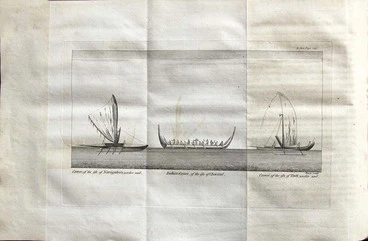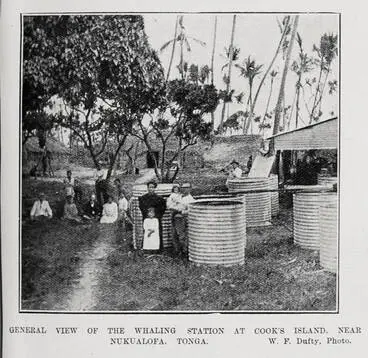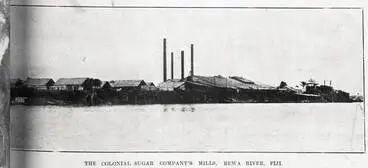Pacific: First Contact with Europeans and Colonisation
A DigitalNZ Story by National Library Services to Schools
This story covers the exploration and colonisation of the Pacific Islands by Europeans, beginning with Abel Tasman sailing along the coasts of Tonga and Fiji in 1642.
Pacific Islands, Cook Islands, Fiji, Samoa, Tonga, Niue, Rarotaonga, Tuvalu, Tokelau.
The view of Huahine, one of the Society Islands in the South Seas
Museum of New Zealand Te Papa Tongarewa
BACKGROUND
The first European to sight the Pacific Ocean was the Spanish explorer, Vasco Nuñez de Balboa, from the isthmus of Panama in 1513. Portuguese Fernão de Magalhães (Ferdinand Magellan) made the first recorded crossing of the ocean less than 10 years later. In the years following, many Spanish and Portuguese navigators sailed across the Pacific.
Source: European discovery of New Zealand - Before Tasman, Te Ara - the Encyclopedia of New Zealand
Reasons for European exploration
- Finding the Great Southern Continent or Terra Australis Incognita – the unknown southern land.
- Trade.
- Scientific interest in discovering new lands, people, culture, flora and fauna.
- To teach people about Christianity.
Reasons for control over the Pacific
- Expansion of empires.
- Business and trade.
- The rivalry between Germany, USA, France, Britain, Germany, Portugal and Spain.
CONTENTS
This story on 'Pacific: first contact with Europeans and colonisation' covers the following:
- Explorers from Europe
- Interest in the Pacific Islands by whalers, missionaries and traders
- Colonisation of the Pacific Islands
- Blackbirding: an effect of colonisation
- Glossary
- Supporting resources
EXPLORERS FROM EUROPE
VOYAGE OF DUTCH VOYAGER ABEL TASMAN — 1642-43
In early January 1643, while off Cape Maria van Diemen in Northland, Tasman supposed there was a passage through to the coast of South America. That such a passage might exist did not rule out the possibility that the land he had discovered was part of a great southern continent. But he did not explore any further. After failing in an attempt to get wood and water at one of the Three Kings Islands, Tasman sailed north to Batavia by way of Tonga, the northern Fiji Islands and New Guinea.
Source: European discovery of New Zealand - Abel Tasman, Te Ara - the Encyclopedia of New Zealand
Tongiaki in Tongatapu, Tonga
Manatū Taonga, the Ministry for Culture and Heritage
British Pacific expeditions
Manatū Taonga, the Ministry for Culture and Heritage
BRITISH INTEREST IN THE PACIFIC — JOHN BYRON, SAMUEL WALLIS AND CAPTAIN COOK
John Byron’s voyage of 1764–66 is generally considered the beginning of serious English interest in the Pacific, which was encouraged by imperial rivalries with Spain, the Netherlands and France. In 1767 Samuel Wallis became the first European to visit Tahiti.
Source: Encounters - European voyaging and discovery, NZHistory
Portrait of Captain James Cook
Museum of New Zealand Te Papa Tongarewa
CAPTAIN COOK'S VOYAGE OF SCIENTIFIC DISCOVERY
By the time Wallis returned to England in May 1768, another expedition to the Pacific was already being organised. The Royal Society had proposed to the British Admiralty that the transit of Venus (the passage of the planet Venus across the face of the sun) be observed in the South Pacific. This observation, combined with others elsewhere, would make it possible to accurately calculate the distance from the Earth to both Venus and the sun. When Wallis returned with news of Tahiti, the expedition was instructed to go there to make the observations.
Lieutenant James Cook was appointed to command the expedition. The ship, renamed Endeavour, departed from Plymouth on 26 August 1768 with 94 men aboard. After entering the Pacific around Cape Horn, it arrived in Tahiti on 13 April 1769 and spent almost four months there.
Source: Encounters - European voyaging and discovery, NZHistory
A dance in Otaheite. Plate 28. From the book: Folio of Plates to Captain Cook's Voyages
Museum of New Zealand Te Papa Tongarewa
A young woman of Otaheite, bring a present. Plate 27. From the book: Folio of Plates to Captain Cook's Voyages
Museum of New Zealand Te Papa Tongarewa
A young women of Otaheite dancing. Plate 29. From the book: Folio of Plates to Captain Cook's Voyages
Museum of New Zealand Te Papa Tongarewa
Venus: A Quest
NZ On Screen
FRENC EXPLORERS — LOUIS ANTOINE DE BOUGAINVILLE, DE SURVILLE AND MARION DU FRESNE
The French became interested in the Pacific at about the same time as the English. Louis Antoine de Bougainville crossed the Pacific on his 1766–69 voyage, in the wake of British explorer John Byron.
De Surville
At the same time that Captain Cook was rounding the top of the North Island in a storm in December 1769, perhaps as close as 40 km to the south-west a French explorer was battling the same heavy seas. Captain Jean François Marie de Surville had left India on the St Jean Baptiste in March 1769 for a voyage of trade and exploration to the South Pacific. Sailing via Malacca and the Solomon Islands, he reached the western coast of New Zealand (he was the first European to see it since Tasman) on 12 December 1769.
Marion du Fresne
Not far behind Cook and de Surville came another Frenchman, Marc Joseph Marion du Fresne, who had served on French India Company ships. He undertook to return a Tahitian, brought by Bougainville to Paris, to his home island. He was also to seek out the legendary southern continent.
Source: European discovery of New Zealand - French explorers, Te Ara - the Encyclopedia of New Zealand
Shows French explorers viewing Easter Island statues, observed by local people seated to the left.
Bottigla, C :Isola di Pasqua. [Early nineteenth century]
Alexander Turnbull Library
In 1766, the voyage of the Boudeuse and L’Etoile under Bougainville became the first official French circumnavigation.
A Voyage Round the World…in the Years 1766, 1767, 1768 and 1769
University of Otago
Article on Louis Bougainville and his Pacific discoveries.
FRENCH PIONEER (Evening Post, 24 December 1929)
National Library of New Zealand
[French Explorers of the Eighteenth Century] - Explorers of the Pacific: European and American Discoveries in Polynesia
Victoria University of Wellington
THE NOBLE SAVAGE
This handsome profile, the bouffant hairstyle recalling Napoleon, is regarded by art historians as an outstanding example of the European concept of the ‘noble savage’. In the romantic period, indigenous peoples who lived close to nature were seen as living a truer life than convention-bound Europeans. This lithograph is based on a sketch by the French artist Louis Auguste de Sainson.
Source: Ideas of Māori origins - 1770s–1840s: early ideas - Portrai tof Natai, 1833, Te Ara - the Encyclopedia of New Zealand
Portrait of Natai, 1833
Manatū Taonga, the Ministry for Culture and Heritage
Tupaia
Manatū Taonga, the Ministry for Culture and Heritage
FAST FACTS
- In 1756, the French historian and geographer Charles de Brosses made up the word Polynesia from the Greek words Poly (many) and nesoi (islands).
- French explorer Louis Antoine de Bougainville named the island of Bougainville after himself when he first contacted it in 1768.
- Bougainville brought back with him in 1769 a Tahitian called ‘Aoutourou’ as a human curiosity. The French Government did think it was a good idea for him to be separated from his culture and ordered him to be taken back. Marion de Fresne, a captain in the French navy offered to take Aoutourou back home.
- Captain Cook could never understand the way Tahitians 'took' other people things. Once when some of his valuable items were stolen, he took away some of their canoes and imprisoned their chiefs.
- Sailors spent months out at sea with little or no supply of fresh fruit and vegetables, causing them to get scurvy due to lack to vitamin C, resulting in skin rash, gum disease, muscle and joint pain and finally death due to these complications.
INTEREST IN THE PACIFIC ISLANDS BY WHALERS, MISSIONARIES AND TRADERS
Whalers
From 1804 the number of whaling ships in the South Pacific grew, as the Napoleonic wars led to attacks on British whaleboats off South America.
During these years whaling was an important industry worldwide. Whales were caught primarily for their oil, which was used to light city streets and lubricate machines. It was also used by cooks for frying food.
Source: Whaling - Ship-based whaling, Te Ara - the Encyclopedia of New Zealand
Missionaries
London Missionary Society
Manatū Taonga, the Ministry for Culture and Heritage
The colonial powers of France, the United Kingdom, and the United States of America considered it their role to bring what they saw as civilisation to the peoples of the Pacific. Missionaries flocked to the islands, eager to save souls. The South Seas was also a fabled region in 19th-century Europe. At a time when romantic notions of nature were popular, the Pacific was seen as an unspoiled paradise.
Source: South Pacific peoples - Early migration - The Pacific Islands, Te Ara - the Encyclopedia of New Zealand
The three main groups of missionaries were:
- The London Missionary Society
- The Wesleyan Missionary Society
- The Roman Catholic Missions
Nauru stripped
Manatū Taonga, the Ministry for Culture and Heritage
Traders
In the early 20th century trade with the South Pacific was dominated by imports of sugar cane from Fiji. The Colonial Sugar Refining Company built up sugar plantations and milling operations in Fiji, and opened a refinery in Birkenhead, Auckland, in 1884.
The second major Pacific trade commodity was rock phosphate, which is formed from bird droppings or animal bones that have dried and built up over a long period. This is combined with sulfuric acid to make superphosphate, the main fertiliser used on New Zealand’s pastoral farms since the 1930s.
The trade began after large reserves of rock phosphate were discovered on Banaba (Ocean Island) and Nauru, then a German protectorate. Similar large deposits were found soon afterwards on Makatea (Aurora Island) in what is now French Polynesia, and Angaur in the Caroline Islands (now Palau).
Originally guano (bird droppings) was imported, but this was replaced by rock phosphate in the first decade of the 20th century. From the early 1920s until the mid-1980s phosphate was New Zealand’s main import from the Pacific region.
The privately owned Pacific Phosphate Company controlled the early phosphate trade on Nauru, Banaba and Makatea. The company’s interests in Nauru and Banaba were taken over by the British Phosphate Commission in 1919.
Source: South Pacific economic relations - Sugar and phosphate, Te Ara - the Encyclopedia of New Zealand
Fijian Sugar Field, Mango [Mago], Loading The Cane
Museum of New Zealand Te Papa Tongarewa
FAST FACTS
- Beachcombers were sailors who were shipwrecked, abandoned by captains or convicts who escaped from Australia. Many choose to live with the natives on the Pacific Islands.
- The London Missionary Society introduced a special rule in Tahiti called Blue Laws. One of the laws laid down what you could and could not do on Sundays.
- Blackbirding was a kind of slave trade. Peruvian ships visited islands such as Tuvalu and Easter Islands and tempted people on board. They then sailed off with them and forced them to work on guano mines off the coast of South America.
- Germitiyas were indentured labourers from India taken by the British to work on plantations in the colonies. The girmit (agreement or contract) was the agreed amount of money and time that the labourers were hired to work for, after which they were free to return to India.
- Commercial whaling was banned in 1986 under the International Whaling Commission. Iceland, Norway and Japan continue to hunt whales under for scientific research.
The Union Jack raised in October 1900 in the Cook Islands.
Cook Islanders and Niueans were declared British subjects.
Manatū Taonga, the Ministry for Culture and Heritage
COLONISATION OF THE PACIFIC ISLANDS
The foundation of the New South Wales penal colony in 1788, and the expansion of European settlement to Hobart Town in Tasmania, and across the Tasman Sea to New Zealand, soon fostered sporadic trade linkages with the Pacific Islands.
In the late 19th century most New Zealand (and Australian) politicians aspired to political ascendancy in the Pacific. New Zealand was ‘ordained by nature to be future Queen of the Pacific,’2 claimed MP for Auckland East (and former Governor and Premier of New Zealand) Sir George Grey, who in 1883 introduced a Confederation and Annexation Bill to allow the building of an island empire. The Polynesian schemes of New Zealand delegates at the Inter-Colonial Convention of November 1883 – like those advanced in the 1870s – attracted little sympathy from the Colonial Office (responsible for running Britain’s empire). Grey’s bill did not receive the royal assent.
Rivalry over commercial linkages, land acquisition and strategic issues helped drive New Zealand’s interest in the Pacific Islands. Deep-water harbours like those in Tonga’s Vava’u or Samoa’s Pago Pago were eagerly sought by the world’s industrial powers, generating fears in New Zealand of maritime dominance by potential enemies.
Source: Pacific Islands and New Zealand - Colonisation and trade in the Pacific, Te Ara - the Encyclopedia of New Zealand
Flag (Union Jack flag with Fijian crest)
Museum of New Zealand Te Papa Tongarewa
FAST FACTS
- Pacific island natives thought the first white Europeans were ghosts or supernatural beings.
- The French declared their control over Marquesas and Tahiti in 1842 and New Caledonia in 1853. They went on to annex other nearby islands. This is called French Polynesia today.
- Fiji’s chiefs accepted British rule in 1874 to protect themselves from American traders, blackbirding, white planters and invasion from hill tribes.
- In 1889, Samoa had warships from Germany, American and Britain in its surrounding waters. All vying for control over Samoa.
- Niue became part of the British rule in 1900. The British then handed over Niue and the Cook Islands to New Zealand for annexation.
Sailing ship which conveyed indentured labour from the Solomon Islands, Samoa
Alexander Turnbull Library
BLACKBIRDING: AN EFFECT OF COLONIALISM
New Zealand received its first known shipload of labourers from the Pacific Islands when the clipper schooner Lulu docked in Waitematā Harbour with ‘a quantity of cocoanuts, &c.,’ and 27 adult male passengers from Sandwich Island (Efate) in the New Hebrides (Vanuatu).
The press soon discovered that these ‘blacks’ were to be employed in flax mills near Auckland.
More doubt was thrown on the enterprise with the publication of extracts from the captain’s diary which suggested he had bribed chiefs to provide labourers for ‘a term of years’. This was the era of ‘blackbirding’, when tens of thousands of indentured labourers were shipped from Pacific islands to the plantations and mills of Queensland, Fiji and Tahiti. After working for years, they were sent home with a few metal goods, such as axes – and sometimes, rifles.
Source: Pasifika labourers arrive in Auckland, NZHistory
THE PACIFIC ISLANDS SLAVE TRADE. (Wellington Independent, 21 November 1871)
National Library of New Zealand
Article on the benefits of Christianity and colonialism in the Pacific Islands.
CHRISTIANITY IN THE PACIFIC (Waiapu Church Gazette, 01 June 1929)
National Library of New Zealand
Unexploded bombs from World War II pose an environmental danger, as well as an explosive one.
Threat posed to the Pacific by unexploded bombs
Radio New Zealand
FAST FACTS
- In November 2019, Bougainville voted overwhelmingly to become independent from Papua New Guinea, aiming to become the world’s newest nation.
- Cook Islands, Nuie and Tokelau are all part of the Realm of New Zealand, which means they share the same Head of State as New Zealand, Her Majesty the Queen.
- In 1962, Western Samoa became the first Pacific Island nation to gain political independence.
- In French Polynesia, many people lost their lands to the European settlers.
- Many Pacific islanders fought in World War 1. Niue enlisted 150 soldiers to fight alongside Australians and New Zealanders in the trenches.
The Colonial Sugar Company's mills on the Rewa River, Fiji
Auckland Libraries
GLOSSARY
Definitions below have been taken from theOxford Learner's Dictionary
ascendancy- the position of having power or influence over somebody/something.
bouffant - (of a person’s hair) in a style that raises it up and back from the head in a high round shape.
circumnavigation - the act of sailing all the way around something, especially all the way around the world.
expedition - an organized journey with a particular purpose, especially to find out about a place that is not well known.
isthmus - a narrow piece of land, with water on each side, that joins two larger pieces of land.
legendary - very famous and talked about a lot by people.
SUPPORTING RESOURCES
A brief history of Tonga — starting from the migration of Lapita people from Southeast Asia, first contact with Europeans till the Kingdom of Tonga today.
Captain Cook's third voyage (Jul 1776-Oct 1780) — an account of Captain Cook's death in Kealakekua Bay in Hawaii.
The Cook Islands: What is our past — a quick look at the history of the Cook Islands from pre- European time to self-rule and democracy.
EPIC— find more information on this topic on EPIC. Databases recommended: Britannica School, National Geographic Kids, World History ( Gale in Context). School login maybe required.
GIRMIT.org — Girmitiyas” or Indentured Labourers, is the name given the Indians who left Indian in the middle and late 19th Century to serve as labourers in the British colonies, like Fiji.
Many Answers— this website will guide you to reviewed websites and databases on the Pacific Islands.
Motives and methods: missionaries in Tonga in the early 19th century — the introduction of Christianity to Tonga by the London Wesleyan Methodist Missionary Society.
New Caledonia’s timeline of injustice to independence — Captain Cook discovers Grande Terre in 1774 and renames it New Caledonia.
Niue - a brief history — Captain James Cook called Niue ‘The Savage Island’ after several attempts to land were met with a hostile reception.
The Pacific slave trade — an article on tricks employed by sailors to trap and capture natives from the islands, then sail away with them to be sold in slave markets.
PNG: 40 years of independence, but still dealing with Australian colonialism — when Australia’s “colonial” history is mentioned, it almost always refers to the period 1788-1901. Little attention is given to Australia’s 20th-century empire of Papua New Guinea and Nauru.
‘Recolonising’ the Pacific would stir security backlash — Australia’s recent Foreign Policy White Paper says that Australia’s approach in the region will focus on “helping to integrate Pacific countries in the Australian and New Zealand economies and our security institutions”.
Tupaia: Master Navigator — the story of Tupaia, a navigator and high priest from the island of Rā‘iātea.
Sailing Ship Model - HM Bark Endeavour, 1768-1771
Museums Victoria
This story was curated and compiled by Te Puna Mātauranga o Aotearoa | National Library of New Zealand, Services to Schools staff, March 2020.











